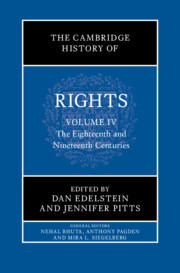Book contents
- the cambridge history of rights
- The Cambridge History of Rights
- The Cambridge History of Rights
- Copyright page
- Contents
- Figures
- Contributors to Volume IV
- General Introduction
- A Note on Translations
- Introduction to Volume IV
- Part I A Revolution in Rights?
- 1 Barbeyrac’s Intervention
- 2 Rights and the Bourgeois Revolution
- 3 Social Rights
- 4 Enlightenment Theories of Rights
- 5 Rights, Property, and Politics
- 6 Antislavery in the Age of Rights
- 7 Enlightenment Constitutionalism and the Rights of Man
- 8 Fundamental Rights at the American Founding
- 9 Declarations of Rights
- 10 The Rights of Women (or Women’s Rights)
- 11 The Image of Rights in the French Revolution
- Part II Postrevolutionary Rights
- Part III Rights and Empires
- Index
- References
11 - The Image of Rights in the French Revolution
from Part I - A Revolution in Rights?
Published online by Cambridge University Press: 22 January 2025
- the cambridge history of rights
- The Cambridge History of Rights
- The Cambridge History of Rights
- Copyright page
- Contents
- Figures
- Contributors to Volume IV
- General Introduction
- A Note on Translations
- Introduction to Volume IV
- Part I A Revolution in Rights?
- 1 Barbeyrac’s Intervention
- 2 Rights and the Bourgeois Revolution
- 3 Social Rights
- 4 Enlightenment Theories of Rights
- 5 Rights, Property, and Politics
- 6 Antislavery in the Age of Rights
- 7 Enlightenment Constitutionalism and the Rights of Man
- 8 Fundamental Rights at the American Founding
- 9 Declarations of Rights
- 10 The Rights of Women (or Women’s Rights)
- 11 The Image of Rights in the French Revolution
- Part II Postrevolutionary Rights
- Part III Rights and Empires
- Index
- References
Summary
This chapter calls attention to the dream world of aesthetic representations that almost immediately engulfed the 1789 Declaration of the Rights of Man and of the Citizen, as well as its 1793 successor. These representations played an important political role, notably by legitimating and disseminating the foundations of the new regime. This visual language, widely viewed as more popular and (after 1792) republican, also influenced the meaning of the Declaration, by emphasizing both its universal applicability to all (including, eventually, enslaved) peoples, and its “lethality” for both internal enemies and foreign tyrants.
Keywords
- Type
- Chapter
- Information
- The Cambridge History of Rights , pp. 260 - 296Publisher: Cambridge University PressPrint publication year: 2024

